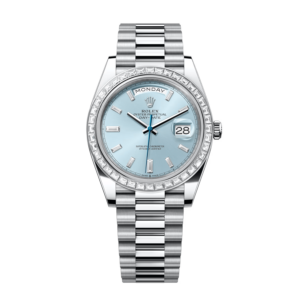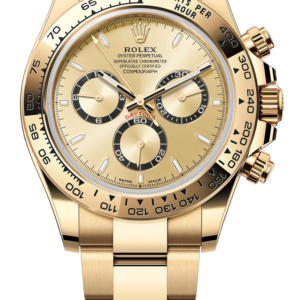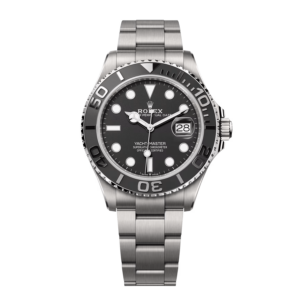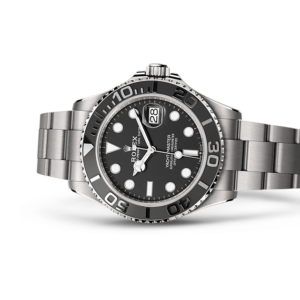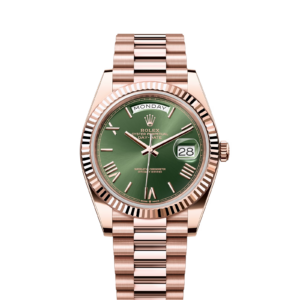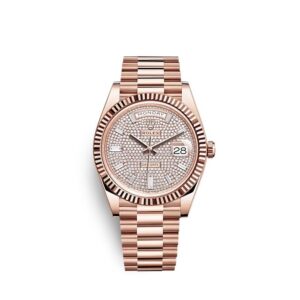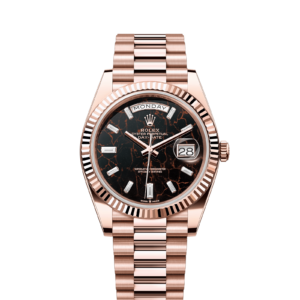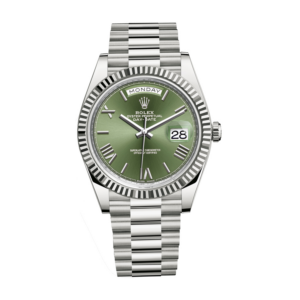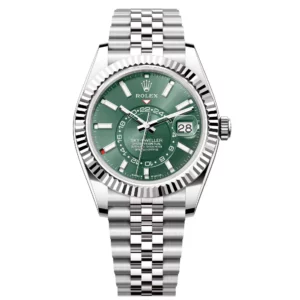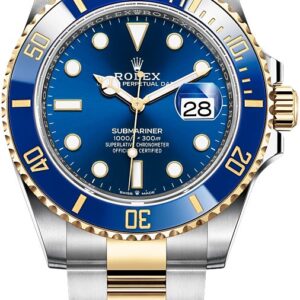Alfred Davis and his brother-in-law Hans Wilsdorf founded Wilsdorf and Davis, the company that would eventually become Rolex SA, in London in 1905. Wilsdorf and Davis’s main commercial activity at the time involved importing Hermann Aegler’s Swiss movements to England and placing them in watch cases made by Dennison and others. These early wristwatches were sold to many jewellers, who then put their own names on the dial. The earliest watches from Wilsdorf and Davis were usually hallmarked “W&D” inside the caseback.
In 1908, Wilsdorf registered the trademark “Rolex”, which became the brand name of watches from Wilsdorf and Davis. He opened an office in La Chaux-de-Fonds, Switzerland. Wilsdorf wanted the brand name to be easily pronounceable in any language, and short enough to fit on the face of a watch. He also thought that the name “Rolex” was onomatopoeic, sounding like a watch being wound.
During World War I, Rolex manufactured trench watches.[better source needed] In November 1915, the company changed its name to Rolex Watch Co. Ltd. In 1919, Hans Wilsdorf moved the company from England to Geneva, Switzerland, because of heavy post-war taxes levied on luxury imports and high export duties on the silver and gold used for the watch cases. In 1919 the company’s name was officially changed to Montres Rolex SA and later in 1920 to Rolex SA.
With administrative worries attended to, Wilsdorf turned the company’s attention to a marketing challenge: the infiltration of dust and moisture under the dial and crown, which damaged the movement. To address this problem, in 1926 a third-party casemaker produced a waterproof and dustproof wristwatch for Rolex, giving it the name “Oyster”. The original patent attributed to Paul Perregaux and Georges Peret, that allowed the watch to be adjusted while maintaining protection from water ingress was purchased by Rolex and heavily marketed. The watch featured a hermetically sealed case which provided optimal protection for the movement.
As a demonstration, Rolex submerged Oyster models in aquariums, which it displayed in the windows of its main points of sale. In 1927, British swimmer Mercedes Gleitze swam the English Channel with an Oyster on her necklace, becoming the first Rolex ambassador. To celebrate the feat, Rolex published a full-page advertisement on the front page of the Daily Mail for every issue for a whole month proclaiming the watch’s success during the ten-hour-plus swim.
In 1931, Rolex patented a self-winding mechanism called a Perpetual rotor, a semi-circular plate that relies on gravity to move freely. In turn, the Oyster watch became known as the Oyster Perpetual.
Upon the death of his wife in 1944, Wilsdorf established the Hans Wilsdorf Foundation, a private trust, in which he left all of his Rolex shares, ensuring that some of the company’s income would go to charity. Wilsdorf died in 1960, and since then the trust has owned and run Rolex SA.
-
ROLEX SEA-DWELLER DEEPSEA Yellow Gold Blue Dial 136668LB
The Oyster Perpetual Rolex Deepsea in 18 ct yellow gold with a Cerachrom bezel insert in blue ceramic and an Oyster bracelet.
Estimated delivery on 15 - 21 April, 2025$92,800.00 EAN: 076000131488 -
ROLEX DAY-DATE 40 OYSTER PLATINUMS AND DIAMONDS, M228396TBR-0002
The ice blue dial is the discreet and exclusive signature of a Rolex platinum watch. Rolex uses platinum, the noblest of metal, for the finest of watches. These exclusive dials can be found only on the Day-Date and the Cosmograph Daytona.
Estimated delivery on 15 - 21 April, 2025$139,000.00 EAN: 077000115140 -
ROLEX COSMOGRAPH DAYTONA 126508-0005 (2023)
This Rolex Oyster Perpetual Cosmograph Daytona in 18 ct yellow gold, with a golden dial and an Oyster bracelet, features an 18 ct yellow gold bezel with an engraved tachymetric scale.
Estimated delivery on 15 - 21 April, 2025$96,000.00 EAN: 164000109849ROLEX COSMOGRAPH DAYTONA 126508-0005 (2023)
$96,000.00 -
ROLEX GMT MASTER II 126713GRNR 2023 LUXURY TIMEPIECE
The Oyster Perpetual GMT-Master II in Oystersteel and yellow gold with a black dial and a Jubilee bracelet.
Estimated delivery on 15 - 21 April, 2025$48,900.00 EAN: 111000109140 -
ROLEX YACHT-MASTER NEW 42MM 226627-0001
Buy New Rolex Yacht-Master 42 in RLX titanium with an intense black dial and an Oyster bracelet.
Light and robust, the new Oyster Perpetual Yacht-Master 42 in RLX titanium is the ally of those seeking freedom of movement. Especially suited to the demands and pressures of competitive sailing, it puts watchmaking excellence at the service of sporting performance. The Yacht-Master 42 is the second watch in RLX titanium released by Rolex after the Oyster Perpetual Deepsea Challenge, confirming that lightness is a quality to be taken seriously.
Estimated delivery on 15 - 21 April, 2025$55,000.00 EAN: 105000108630ROLEX YACHT-MASTER NEW 42MM 226627-0001
$55,000.00 -
ROLEX DAY-DATE 40 EVEROSE GOLD M228235-0025
Ideal accomplishments
The Rolex Day-Date Oyster Perpetual 40 in 18 kt Everose gold with an olive green dial, fluted bezel and a President bracelet.
Estimated delivery on 15 - 21 April, 2025$52,800.00 EAN: 119000107180ROLEX DAY-DATE 40 EVEROSE GOLD M228235-0025
$52,800.00 -
ROLEX DAY-DATE EVEROSE GOLD 2021 M228235-0036
Ideal accomplishments
The Oyster Perpetual Day-Date 40 in 18 ct Everose gold with a diamond-paved dial, fluted bezel and a President bracelet.Estimated delivery on 15 - 21 April, 2025$97,800.00 EAN: M228235-0036 -
ROLEX DAY-DATE 40 EVEROSE GOLD 228235-0045
Ideal accomplishments
The Rolex Day-Date Oyster Perpetual 40 in 18 ct Everose gold with an eisenkiesel, diamond-set dial, fluted bezel and a President bracelet.
Estimated delivery on 15 - 21 April, 2025$89,000.00 EAN: 228235-0045ROLEX DAY-DATE 40 EVEROSE GOLD 228235-0045
$89,000.00 -
ROLEX DAY-DATE 40 OYSTER, WHITE GOLD M228239-0033
ROLEX DAY-DATE 40 OYSTER, WHITE GOLD M228239-0033
The dial is the distinctive face of a Rolex watch, the feature most responsible for its identity and readability. Characterised by hour markers fashioned from gold to prevent tarnishing, every Rolex dial is designed and manufactured in-house, largely by hand to ensure perfection.
Estimated delivery on 15 - 21 April, 2025$58,000.00$59,000.00EAN: 098000104057ROLEX DAY-DATE 40 OYSTER, WHITE GOLD M228239-0033
$58,000.00$59,000.00 -
ROLEX SKY-DWELLER OYSTER 42mm, OYSTERSTEEL AND WHITE GOLD 336934
ROLEX SKY-DWELLER OYSTER 42 mm, OYSTERSTEEL AND WHITE GOLD 336934
With its two time zones and its annual calendar, the Sky-Dweller is an elegant and trusted companion for world travelers. The range has been updated with numerous enhancements proving that, for Rolex, excellence plays out even in the tiniest details.
Aesthetic embellishments are introduced with new versions joining the range. And, the watch sees technical evolutions with the introduction of a movement equipped with the latest advances in Rolex technology.
Estimated delivery on 29 April - 15 May, 2025$45,600.00 EAN: 143000103200 -
ROLEX SKY-DWELLER OYSTER, WHITE GOLD M336934-0001
Rolex Sky-Dweller reference 336934-0002, which is part of the second generation of Sky-Dweller watches and was introduced in 2023. This exceptional timepiece is powered by the updated caliber 9002, which is an evolution of the original 2012 caliber 9001, showcasing Rolex’s commitment to continuous innovation and excellence in watchmaking.
The Rolex Sky-Dweller 336934-0002 features a stainless steel case with a bezel crafted from white gold, giving it a perfect blend of durability and elegance. The 42mm Oyster architecture monobloc middle case, screw-down case back, and winding crown ensure the watch’s water resistance and robustness, making it suitable for any adventure, whether you are exploring the depths of the ocean or traversing the skies.
One of the unique characteristics of the Sky-Dweller reference 336934-0002 is its striking green dial. This Mint green dial exudes sophistication and freshness, adding a pop of color to your wrist. The dial features luminous baton hour markers and hands, providing excellent legibility in any lighting conditions. The annual calendar function, which automatically displays the correct date, month, and day of the week, adds convenience to your daily life, making this watch not just a timepiece, but a practical companion.
The Rolex Sky-Dweller 336934-0002 also features the iconic fluted, bidirectional rotatable Rolex Ring Command bezel, which allows you to easily adjust the watch’s different functions by simply rotating the bezel. This innovative bezel design makes setting the watch a breeze, providing a seamless user experience.
The watch is presented on a stainless steel Oyster bracelet, providing a comfortable and secure fit on the wrist. However, if you prefer a different style, this reference is also available with a Jubilee bracelet (reference 336934-0002), which adds a touch of elegance and sophistication to the timepiece.
The caliber 9002 movement powering the Sky-Dweller 336934-0002 includes technical innovations such as the Chronergy escapement, Paraflex shock absorbers, and a new oscillating weight with an optimized ball bearing. These advancements enhance the accuracy, durability, and reliability of the watch, ensuring that it performs impeccably for years to come.
Estimated delivery on 15 - 21 April, 2025$58,900.00 EAN: 155000102800 -
ROLEX SUBMARINER DATE 126613LB-002 TWO TONE “BLUESY”
The Rolex Bluesy Oyster Perpetual Submariner Date in Oystersteel and yellow gold with a Cerachrom bezel insert in blue ceramic and a royal blue dial with large luminescent hour markers.
Estimated delivery on 15 - 21 April, 2025$56,000.00 EAN: 147000102621





